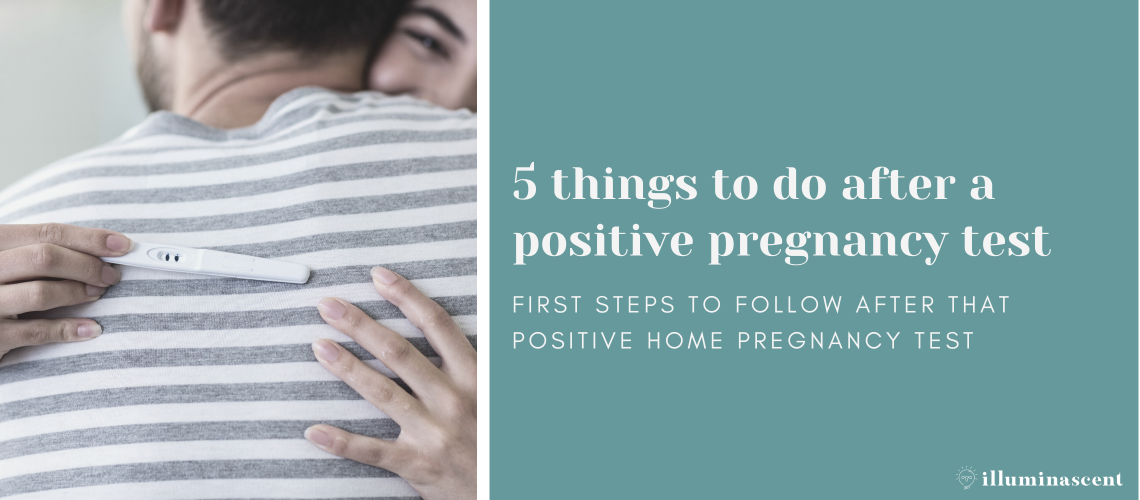Recently, a reader asked for a post about what to do after a positive (planned) pregnancy test. It can be an exciting and nerve-wracking time for many. The journey to that positive test can look so different for each person, and that will absolutely inform the feelings that arise with a positive test or news that you are pregnant. And if this is your first, it’s filled with a lot of ‘firsts’. So here’s a list to help you along the first weeks following those positive lines.
1. Celebrate
Whether this is simply a happy-tear-filled hug in the bathroom or clinic, or ordering-in from your favourite restaurant, take a little ‘yay’ moment. Some people are very good at being happy and laid back about those positive lines. Some are just instantly filled with worry (and joy too, of course), hoping this pregnancy will work out. Whatever camp you fall in, take a moment to be happy.

2. Continue to take your prenatal vitamins
Hopefully, you started prenatal vitamins (with activated folic acid, like folate) at least 3 months prior to pregnancy. Continue to take them, and if you haven’t yet started, start ASAP. Like, now.
I feel like this goes without saying – but stop drinking alcohol, smoking, and using marijuana or illicit drugs. The number of things that have to go right to grow a baby is beyond large, so why not give it your body and baby its best chance? Stick with caffeine intake around 200mg or less daily – higher amounts have been associated with miscarriage in the first trimester.

3. Decide on the type of provider you would like
This item deserves a post all on its own (one day!). In Canada, the two main options are obstetrician (OB) or midwife. Midwives are covered by provincial health plans, as OBs are. Additionally, many family physicians and OBs do a ‘shared care’ model where you see both providers during your pregnancy.
If you want to see a midwife, look for local midwifery practices that are open to people living in your area, and get registered for care. Midwives can be hard to get into in some areas, so do this as soon as you can.
If you want to see an OB, your family doctor can refer you to one. You can ask to be referred to a certain OB, or your family physician can recommend one.

4. See your family doctor
This isn’t completely necessary for all (though you will need to do this if you want referral to an OB). If you would like, your family physician can confirm pregnancy. They may also order 1st trimester bloodwork, or schedule a dating ultrasound. Midwives can do this as well.

5. Decide who you would like to tell, and when
This is a personal choice for everyone. With our first, I didn’t give this much consideration and just thought we would wait until 12 weeks/the end of the first trimester to tell our families like everyone else we knew seemed to do.
But then we found ourselves sitting in the ER when I was 8 weeks pregnant and bleeding, and I wanted to call my mom, but also didn’t want to have to say ‘I’m pregnant but also maybe not’. I decided right then that once this whole emergency room thing was over, we were telling our families. And we did.
And with each pregnancy afterwards, we shared our news with parents and siblings as soon as we were able to see them in-person, usually around 7 or 8 weeks. I wanted them to be there if something went wrong with the pregnancy, and to not have us shoulder it alone.
Decide what works for you. Some people prefer to keep everything to themselves until later, like the end of the first trimester around 12 weeks. For us, that’s when we shared our news with most friends.
The decision of when to tell work is also a personal choice. Some people need to share earlier based on workplace safety protocols, others wait until the first ultrasound, some until the anatomical ultrasound between 18 – 20 weeks. Others, somewhere in the middle of all of that. Decide what makes sense for you.

Anything else?
That’s about it! The first trimester feels long. Most people in your life likely don’t know you’re pregnant. You may feel tired, sick, and unable to stand certain foods and smells. Breathing cold air may make your dry heave (no? just me?). And you may feel totally normal and not pregnant at all (which I’ve heard is nice, but also anxiety-inducing, so be gentle with yourself). Continue to move your body, a simple daily walk counts!
Once you have the energy of the second trimester, then you can get planning and preparing. Get on daycare waitlists. Consider your maternity leave options. Stay hydrated. Sign up for prenatal classes. Read all the books.
But the first trimester? It’s about rest as your body uses all your energy to build a brand new organ – the placenta, that will nourish that developing fetus of yours.

